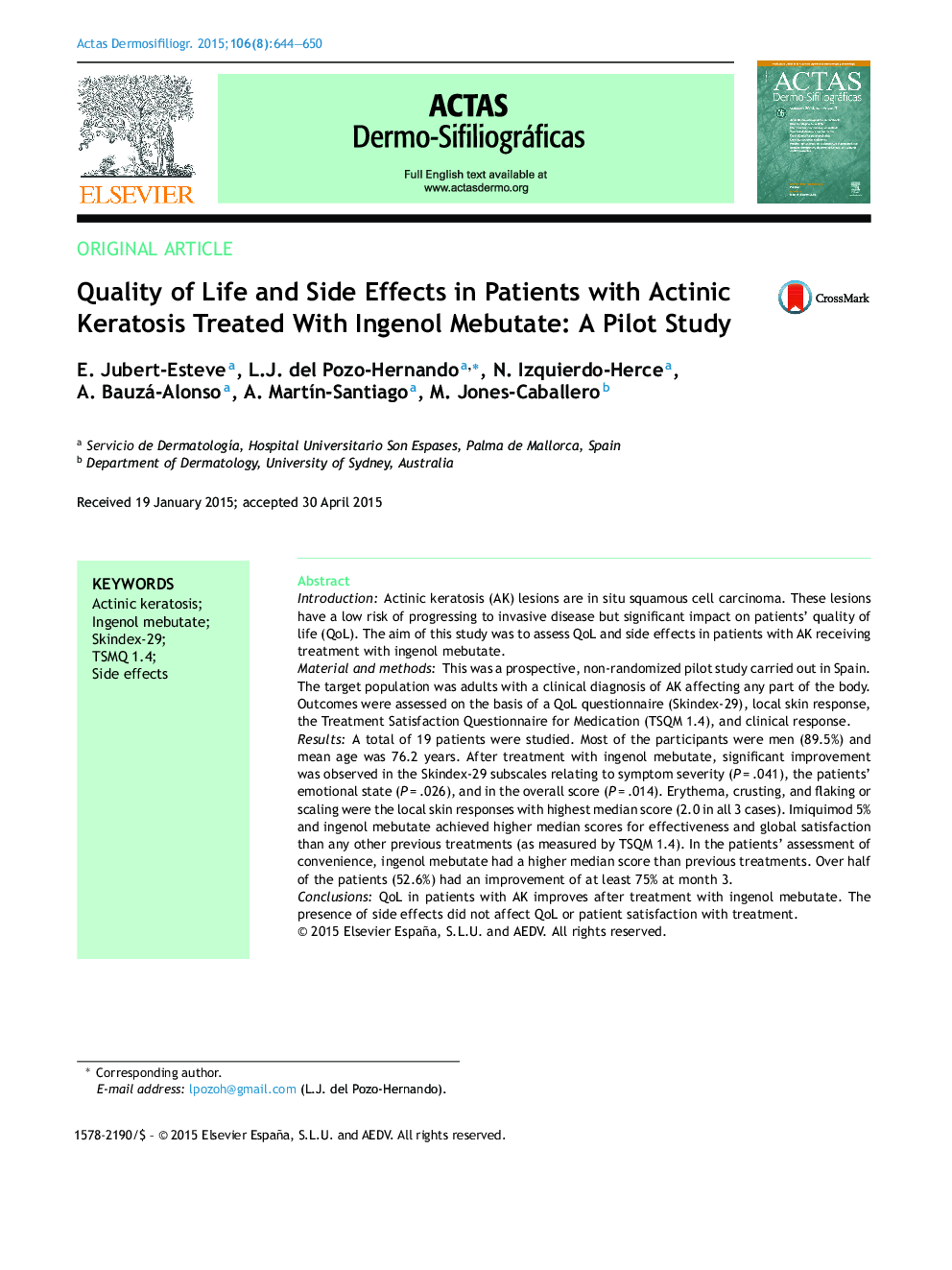| Article ID | Journal | Published Year | Pages | File Type |
|---|---|---|---|---|
| 3182611 | Actas Dermo-Sifiliográficas (English Edition) | 2015 | 7 Pages |
IntroductionActinic keratosis (AK) lesions are in situ squamous cell carcinoma. These lesions have a low risk of progressing to invasive disease but significant impact on patients’ quality of life (QoL). The aim of this study was to assess QoL and side effects in patients with AK receiving treatment with ingenol mebutate.Material and methodsThis was a prospective, non-randomized pilot study carried out in Spain. The target population was adults with a clinical diagnosis of AK affecting any part of the body. Outcomes were assessed on the basis of a QoL questionnaire (Skindex-29), local skin response, the Treatment Satisfaction Questionnaire for Medication (TSQM 1.4), and clinical response.ResultsA total of 19 patients were studied. Most of the participants were men (89.5%) and mean age was 76.2 years. After treatment with ingenol mebutate, significant improvement was observed in the Skindex-29 subscales relating to symptom severity (P = .041), the patients’ emotional state (P = .026), and in the overall score (P = .014). Erythema, crusting, and flaking or scaling were the local skin responses with highest median score (2.0 in all 3 cases). Imiquimod 5% and ingenol mebutate achieved higher median scores for effectiveness and global satisfaction than any other previous treatments (as measured by TSQM 1.4). In the patients’ assessment of convenience, ingenol mebutate had a higher median score than previous treatments. Over half of the patients (52.6%) had an improvement of at least 75% at month 3.ConclusionsQoL in patients with AK improves after treatment with ingenol mebutate. The presence of side effects did not affect QoL or patient satisfaction with treatment.
ResumenIntroducciónLas queratosis actínicas (QA) se consideran carcinomas espinocelulares “in situ” con poca capacidad invasiva pero con un impacto significativo en la calidad de vida (CV). El objetivo fue evaluar la CV y los efectos secundarios de ingenol mebutato (IM) en pacientes con QA.Material y métodosEstudio piloto, prospectivo, no aleatorizado, en pacientes >18 años, con diagnóstico clínico de QA de cualquier localización. Se valoraron: la CV, mediante el cuestionario Skindex- 29; la satisfacción con el tratamiento mediante el cuestionario TSQM 1.4; la respuesta clínica, y la reacción cutánea local (RCL).ResultadosSe incluyeron 19 pacientes, el 89,5% eran hombres, con una edad media 76,2 años. Después del tratamiento con IM, se observó una mejoría significativa en las subescalas del Skindex-29 (emocional y sintomática) y en la puntuación global (p = 0,026, p = 0,041 y p = 0,014), respectivamente). Al día 3–4, el eritema, la costra y la descamación fueron las RCLs con una mediana de puntuación más alta (2,0, en los 3 casos). La efectividad y la satisfacción global (según TSQM 1,4) presentaron puntuaciones medianas más altas con imiquimod 5% e IM comparado con los otros tratamientos previos. La valoración de la conveniencia mostró una puntuación más alta en IM comparado con los otros tratamientos previos. Más de la mitad de pacientes (52,6%) lograron una mejoría ≥75% al tercer mes.ConclusionesLa CV en pacientes con QA mejora después del tratamiento con IM. La presencia de efectos secundarios no afecta ni a la CV ni a la satisfacción de los pacientes con el tratamiento.
